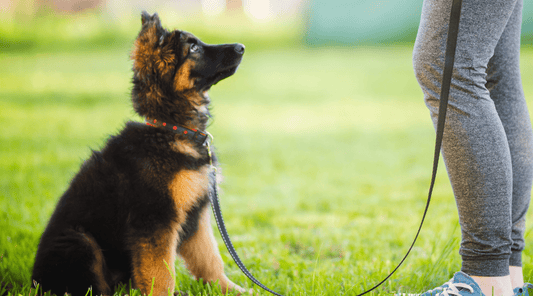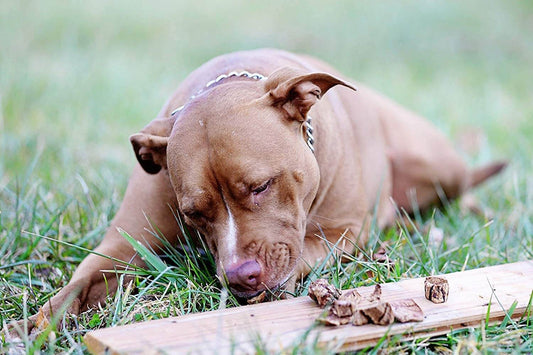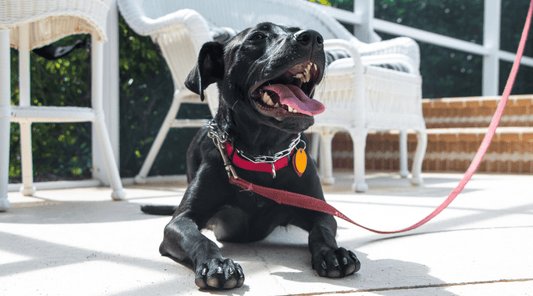
How to Train a Dog Not to Jump on People: The Ups and Downs of Learning
Dawn Miller Jan 21, 20255 Minute ReadFrom an early age, jumping up on people becomes a way for a dog to say, "I'm so happy to see you. Let's play!". But like teaching a child how to act at the dinner table, dog manners training is important to dog development.
We all learn what's socially acceptable by how people respond to our actions. If you want to stop a dog from jumping, you must communicate in a way they understand.
A few weeks ago, my neighbors hosted their annual cookout. As more people filed into the backyard, there were humans, dogs, and enough chaos to keep things interesting. And it became evident that my neighbor's French Bulldog, Pierre, didn't know what to do.
He wanted to greet everyone who entered through the back gate with excited paws and some slobber. While most people laughed it off, one guest—not a fan of enthusiastic dog hugs—was startled at the sudden affection. He almost dropped the massive tub of black bean dip he'd brought for the occasion.
This reminded me of why I learned how to train a dog not to jump up on people. Dog manners training is important and the right training treats for dogs are invaluable for ensuring that training sticks.
Why Do Dogs Jump on People?
They're not trying to be rude. It's a natural behavior. If you're ever fortunate enough to watch a dog mama with her litter, you'll notice that the pups jump up on her and their littermates in greeting and playing.
The behavior can carry into adulthood if not redirected. If that puppy had stayed with their pack of birth, the other members of their crew would have taught them not to do this as they got older and more muscular.
When we get a puppy, we interrupt that natural teaching process. This can impact their "puppy development," so they carry "puppy" behaviors into adulthood.
Now, I'm not saying you should never get a puppy. But this does put the burden of dog manners training on you instead of the dog mama.
Actionable Tips to Stop Dog from Jumping
Training a dog to stop jumping on people takes some time, patience, and consistency. But you know what? It's so rewarding.
Once you start to realize that you can teach your dog basic commands and that dogs can learn up to 165 distinct human words, you'll start to realize how fun and rewarding it can be as a dog parent.
But it's important to teach the way that dogs learn. They don't learn from punishment. That only teaches them that you're mean and unpredictable (not recommended). I
Instead, use positive reinforcement training to show them what they should do when they want to greet someone. That's how to stop a dog from jumping.
1. Teach an Alternate Greeting
Instead of focusing solely on stopping the jumping, teach your dog a positive behavior to replace it. For example, teach them "sit". After training them to sit, you can say "sit" when they jump up on you or others. They will learn that approaching you or a stranger and sitting is better dog manners.
Start by teaching them this command is a room alone without distractions, rewarding them until they learn the command. Once they can do it consistently, it's time to test them.
Invite a neighbor to help you. When someone approaches, have your dog sit before they reach them. Reward with a treat and praise. If the dog starts to jump, calmly step back and wait for them to sit again before offering a reward.
2. Ignore the Jumping
If you miss the opportunity to tell them to sit before they start jumping, ignore them. Turn away and don't reward the behavior negatively or positively. Cross your arms, turn your back, and avoid eye contact when your dog jumps.
Once all four paws are on the ground, say, "sit". When they sit, reward them with calm praise or a dog treat.
3. Teach More Commands
Teaching your dog commands like "stay", "come", and "down" will give you more options to stop a dog from jumping, depending on what the situation calls for.
If your much older neighbor is using a walker or cane, they may not be very stable. You may not want your dog to run up to them and sit. That might startle them.
So, "stay" or "come" can be useful here. You can slowly approach your friend while communicating that your dog should stay at your side.
The "wave" command is another great way to greet guests. After a dog learns to sit, you can easily teach them to extend a paw for a pawshake or wave. See Amanda teach it in this video:
4. Choose High Value Training Treats for Dogs
The fastest and most efficient way to train is with high-value treats. These dog treats are irresistible, so dogs will learn to do backflips for them (if they're able). But they're also nutritious. So, I'm enhancing dog nutrition one treat at a time.
I keep dog training treats on me all the time. I buy beef lung dog treats in bulk to make sure they're available for both intentional training and those impromptu opportunities to reward good dog manners.
5. Provide Mental Stimulation
Mental stimulation is a critical step in stopping undesirable and destructive dog behaviors. A mentally stimulated dog is calmer and they can learn dog manners training faster than a hyper pup. They don't feel bored or anxious. So they're less likely to overreact when you return home from work or a guest arrives.
Regular walks and play are critical. They help a dog feel well and active. They're getting their exercise, so they no longer need to do wall pushups on your pants.
I also incorporate chew sessions several times a week. Each of my dogs gets a meaty beef marrow bone of appropriate size for them. Marrow bones contain naturally occurring buttery bone marrow that releases slowly as a dog chews, licks and flips the bone around. It's like a dog puzzle toy—but without the microplastics.
Beef marrow-filled dog bones are the perfect single-ingredient dog treats for keeping my pups feeling entertained and engaged.
Troubleshooting Common Challenges
What If Your Dog Ignores You?
Hyper dogs, like my terrier Pixie, often struggle to focus. In these cases, start with short, distraction-free training sessions. Gradually add more stimuli, like guests or outdoor environments, as your dog gets better at focusing on you. Also, start that hyper pup on some mentally stimulating chew sessions with healthy dog bone to reduce anxiety and boredom that can lead to an unproductive training session.
What If Guests Encourage Jumping?
This one’s tricky! Be upfront with visitors. Politely ask them not to pet or engage with your dog unless they’re sitting calmly. Consistency from everyone is key.
How Can I Learn How to Do Dog Manners Training?
I'm so glad you asked. I've been meaning to invite you to check out this Free 7-Day Dog Training Challenge. It can take you from "What is dog training anyway?" to feeling like a guru in just 7 days.
Available On:





